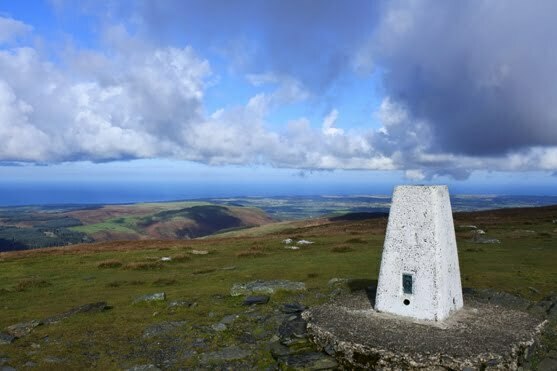
If you climb to the top of the Isle of Man’s highest peak, Snaefell (not too arduous – it’s only 2,000 feet and there’s a train that can take you to the summit), on a clear day you can see across the seas to four lands: England, Scotland, Northern Ireland and Wales. You can also see most of the island laid out before you, since Snaefell is positioned almost centrally. You can survey all of your world: where you reside and where those beyond reside who control your fate. You are in a small place, but with the grandest of views.
I went to the Isle of Man for a week, because I’d never been before and indeed did not know anyone among my acquaintances who had. My vague picture of it was of small seaside resorts, motorcycle races, tailless cats, and some diehard social and political views (it only abolished capital punishment in 1993), birthplace of the Bee Gees and Mark Cavendish. But I had a sense of there being wilder parts that might be interesting to explore, so off I went.
First of all, the basic facts. The Isle of Man is 33 miles long and 13 miles wide. It sits in the Irish Sea, roughly equidistant between England, Scotland, Northern Ireland and Wales. Its highest point is 2,000ft above sea level. It has a population of some 84,000, and has its own government, supposedly dating since 979AD. Its Celtic name is Ellan Vannin. Though part of the British Isles it is not a part of the United Kingdom, being instead a British dependency (therefore much like the Falklands). On paper, and on actually going there, it is just that little bit different.
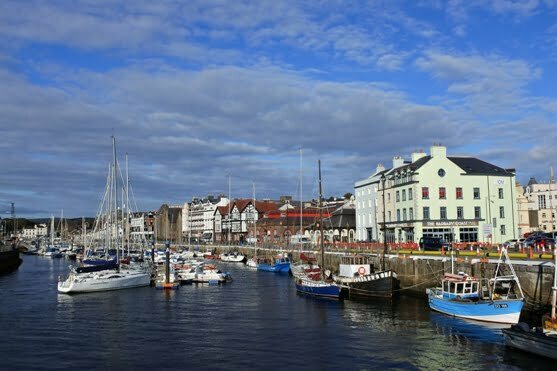
Logically enough, you have to sail or fly to get to the Isle of Man, and if you fly you land at Ronaldsway airport, at the bottom of the island around 40 minutes’ drive out of the main town of Douglas. All Isle of Man adventures start with Douglas. It is by far the largest town on the island (though the Isle really only has six or seven places that qualify as towns), the seat of the government, home to nearly a third of the island’s population, home to the major businesses and the essential transport for discovering the rest of Man.
Douglas sets the tone for the island. It has a faded but not yet abandoned look about it. Built up from the mid-Victorian era to capitalise on a tourist boom, then rejected in the 1960s when the crowds sought out package holidays elsewhere, the buildings with their poorly-tended plaster look too large for requirements. The hotels and guest houses that stretch along the two-mile promenade are five or six storeys high, built to cram in the maximum number of holidaymakers. Today a lesser world applies. Douglas does not quite have the forlorn aspect of some English seaside towns, in that there is a measure of prosperity still, but it has an air of a place that time forgot – as does the Isle of Man as a whole. A sad carthorse pulls a trolley up and down the promenade at weekends. Major attractions are a steam train for journeying south, and a ricketty electric railway for going north. Cultural life seems almost dead – a theatre, two cinemas, no art gallery to speak of, though the excellent Manx Museum bucks the trend with its inventive and informative displays. Pride of place goes to statues of George Formby and Norman Wisdom. Such is Douglas, where the 1950s might well live on into eternity.
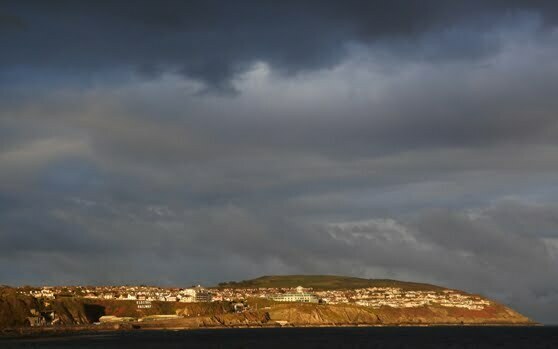
Douglas is a fascinating place to analyse. As with much of the Isle of Man you don’t have to walk far away from civilisation before wildness takes over, and vice versa. Walk beyond the headland and you swiftly come to vertiginous cliffs with jagged rocks below, and you can see how this resort town was carved out of hard nature. Behind the houses to the edge of town, and backing the hotels along the promenade, there are rough rock faces, the residue of millennia topped with a light dusting of human habitation. The roads in the centre of town fold in on one another, zigzagging down slopes in obedience to the unforgiving rock beneath.
And then there are the windows. Douglas is like one long flower bed, in which all the plants strain upwards to the sun. It’s not just the hotels, with their multi-storyed offerings of sea views, but the homes stretching out along the northern headland into the satellite town of Onchan, each of which seems to boast a bay-windowed living room with sun chairs, all pointed towards the complete emptiness of the sea and sky beyond. Why do we value such views of nothingness? What storms lurk within that make us yearn for that blank horizon?
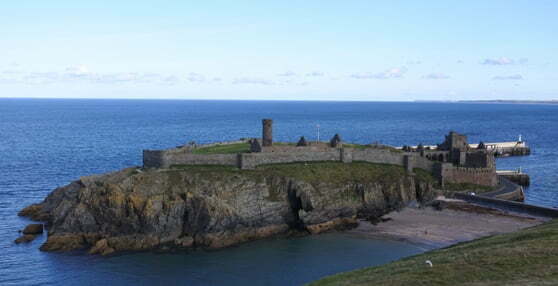
The Isle of Man has an excellent bus service – reliable, frequent and comfortable – and Douglas is the starting point for most such journeys. When you do set out, you quickly discover that promised wildness (40% of the island is said to be uninhabited) and places that bear more of the marks of a long human history. Man comes across as a mixture of Cornwall and the lower reaches of the Lake District. There are those few coastal town built in the few bays of an otherwise unforgiving rocky shoreline, but rather more uplands that you might expect, with hidden glens, small rivers, rather too few trees (thanks to centuries of human woodcutting) and everywhere reminders of the Celtic and Viking heritage, from placenames (many start with Balla, the Manx Celtic word for homestead), to streets signs (all in English and Manx – few speak any of the latter but none are allowed to forget it) to artefacts and buildings.
The Isle of Man has been much fought over, invariably as part of larger land grabs rather than for its own sake. It has been colonised since around 6,500 BC, and was variously taken over by Celts, Vikings (the Romans never bothered), Scots and English. A particularly rich indicator of this is Peel Castle, one of two castles on the island. Located on St Patrick’s Isle, an outcrop connected by a causeway to the charming small town of Peel, it originally housed a Celtic monastery, alongside which was erected a lookout tower in the Irish fashion, around the tenth century. The Vikings added wooden fortifications, then stone walls were built around the perimeter in the fourteenth century. Within small chapels (keeills) and then a whole cathedral (St German) were constructed, followed by armouries, storehouses and barracks as the castle continued in use through to the eighteenth century. The result, though now mostly ruins, is an engrossing hotch-potch of different buildings from succeeding ages, a stone capsule of evolving times.

The other castle, Castle Rushden, is in the opposite state of repair. It is practically in a perfect state. Located in Castletown (previously the capital, and with grand houses and an air if superiority to denote its former state), it is the most complete castle I’ve ever come across. First built in the early thirteenth century, then added to over the next two hundred years to broadly the shape it is today, it feels as though nothing has happened to it since. Every stone is in place, there are wooden floors in every room, the grander rooms for the Lords of Mann are furnished with convincing replica wall hangings, and every corridor, stairwell and turret looks just as the builders left it. Even the dungeon is intact. Exploring the building from room to room is particularly exhilarating, as time collapses and you have this palpable sense of the castle – which is small, as castles go – as a lived-in place. When you read the history of the place you learn how badly neglected it was at times (and badly built originally in some instances), so it’s a miracle of restoration. If you want a good sense of how a castle operated in toto, Castle Rushden is the place to visit.
The Isle of Man is defined by its coastline, but its greatest appeal (for me) lies inland. The green countryside rolls delightfully, then towards the centre a number of peaks arise, reminding you that the Lake District lies parallel to the island – indeed you can see Scarfell Pike and other Cumbrian mountains across the sea on a good day. As noted, the Isle’s highest peak only reaches 2,000 feet, and there is nothing of the ruggedness of Lakeland. A stroll along the hilltops would be just that, a stroll, though with the grandest of views.
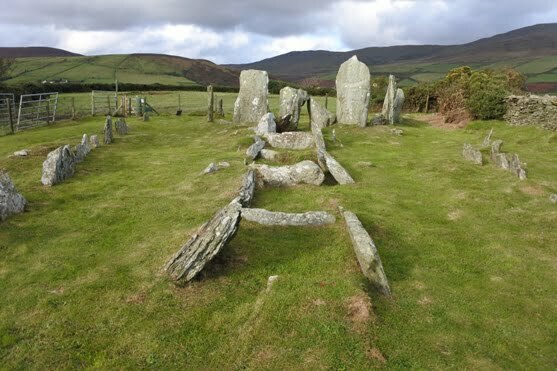
Lower down, where it is mostly farmland, human habitation is confined to small, isolated clusters of houses, some quite grand (the Isle of Man’s generous tax laws have attracted quite a few tax exiles from the UK), few such clusters being sufficient enough to merit the term village. Here is fine walking country, where you will stumble upon scenic, secluded glens, ancient cottages and assorted Celtic and older remains.
I particularly wanted to seek out Cashtal-yn-Ard, the Neolithic tomb near Cornaa in the parish of Maughold. Situated in a walled area in the middle of upland farmland, barely signposted and not at all easy to find, it is the remains of what would have been a spectacular, 130-foot long chambered cairn, with a semi-circular forecourt (at the rear of the above photograph), five chambers within, and a mound where bunrt offerings were made. It is four thousand years old, and even if the roof has gone and only a few outpost stones remain, it still feels remarkable that over such a great period of time we have had sufficient respect to let such places be. We remain in awe of the timeless.
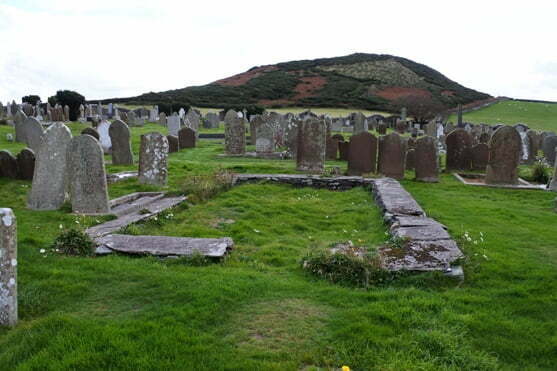
Maughold hamlet is not far away, with iconic coastline views from the rocky outcrop of Maughold Head. Amid half a dozen houses there is the twelfth-century church of St Maughold, a building of modest charm in itself, but with a notable churchyard. There is a covered area with a remarkable collection of Celtic and Norse carved crosses, a museum’s-worth of precious artefacts just standing there. The churchyard also has the outlines of four keeills (presumably so many because the area was once the site of a Celtic monastery). You wonder how they could cram in a congregation into so small a space, until you learn that only the clergy went within – the people stood outside. Among the dead of Maughold parish (who have now spread into a new nearby cemetery) there is an ostentatious rectangular pillar of a gravestone for the Manx novelist Hall Caine, greatly popular a hundred years ago, unread (and indeed scarcely readable) today. He lives on best in Alfred Hitchcock’s fine silent film The Manxman, adapted from his novel.
I visited several other places – the pretty small town of Port St Mary; its drab neighbour Port Erin; the delightful Laxey sprawled over a wooden glen, with trains taking you to the summit of Snaefell; the large-ish but seemingly purposeless resort town of Ramsey to the north, with its disused pier and strangely isolated grand terrace of guest houses along the seafront. Bus journeys took me through the thinly populated north-western places, like Sulby and Ballaugh. But the place I most wanted to see, and my highlight of the week, was at the south-west corner of the island: the Calf of Man.
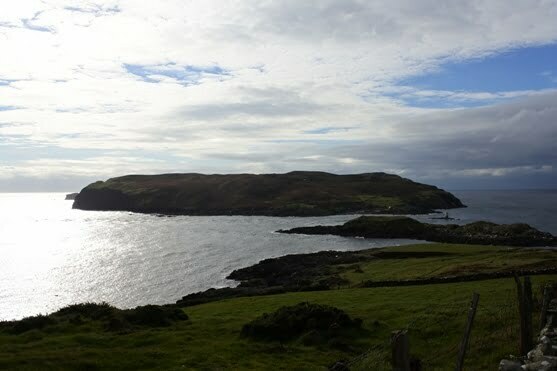
It’s best approached on foot, as if on pilgrimage. I walked up and along the cliff tops from Port Erin, then headed downhill towards Sound, a place with just the one building and a bus stop. And there, out to sea, is a small island, the Calf of Man, separated from the main Isle by a sound of angry tidal waters and the islet of Kitterland. The Calf of Man is about a square mile and in the summer months has a permanent population of two, in its bird observatory. You can contemplate it from the stylish modern café at Sound, with its curved window encompassing the whole grand view, or else from assorted great vantage points along the craggy coastline.
Four lighthouses have been built on the other side of the Calf, and it’s an area where many ships have come to grief. There’s a sad memorial to the brig Lily, which foundered here in 1852. Nine of the crew were rescued by locals, but the ship had been carrying gunpowder and twenty-nine of a salvage team of thirty were killed when the ship exploded some days later, leaving twenty-two widows and seventy-two orphans. The island itself has been home in the past to hermits and runaways, and was farmed into the early half of the twentieth century (amazingly this included cattle farming, the animals having to swim across the sound). Now it is owned by the National Trust.
Visits can be organised, but the Calf of Man is far better imagined as an empty spot, where we may contemplate desolation. We live on rocks, surrounded by sea, governed by the sky. The Isle of Man brings this human situation into sharp focus, presenting us with a world in miniature. Like all islands it has that sense, however false in reality, of self-sufficiency, of being the world unto itself, completely defined. The Calf of Man is one step on from such civilisation, leading on to the limitless beyond.
Links:
- There is an album of photographs from my trip to the Isle of Man on my Flickr site
- Manx Scenes Photography is an excellent annotated photography site, lovingly dedicated to the minutiae of Manx life and scenery
- There’s a useful guide to Manx heritage locations at Manx National Heritage
- Find out more about Hall Caine, “once considered the equal of Tolstoy”, at the Manx Literature site
- The Manx Museum has an excellent digital online version of itself, the iMuseum, with photographs, manuscripts, newspapers and posters
- And finally, the Bee Gees sing ‘Ellan Vannin‘, the unofficial Manx national anthem …
Lovely piece Luke
Thank you Matt. I thought it a fascinating place. Maybe the post will encourage others to explore it as well.
Nice piece. You have caught the essence of the island very well from a single visit. Excellent photos too – thanks for sharing them.
Thank you. It’s always going to be a bit superficial trying to sum such a place on just a week’s stay, but I saw more than enough to inspire me and I hope to return before too long.
Lovely blog post. I thought I would share something I learnt recently that (although the Isle of Man was a bit late to abolish capital punishment) they gave women the vote in 1880.
Indeed that’s true. And though they were late in abolishing capital punishment, they last executed someone in 1872. And only last week they were shown to be ahead of the UK in granting civil partnerships for heterosexual couples – see http://www.bbc.co.uk/news/world-europe-isle-of-man-37720440